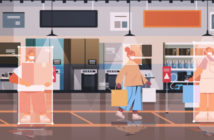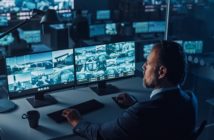 By Dr. Dave Brooks and Jeff Corkhill.
By Dr. Dave Brooks and Jeff Corkhill.
Closed circuit television (CCTV) has become a common form of technology, infused within many parts of our life, such as public, private, social and work environments. Whether CCTV is used in the media in a voyeuristic mode for the production of Big Brother, in public transport to reduce assaults or in a public street surveillance system to improve safety, the technology is in essence the same.
Over the last 20 years, there has been much discussion on CCTV effectiveness. This discussion, in particular from the UK, has been significant in its scope. On the 19th of April 2011 a major security incident occurred at Sydney Airport, one that had a knock on effect felt right around the nation. This incident occurred after a power failure allowed a number of passengers to pass through a security screening point, without being effectively screened.
In response, the airport was evacuated and all passengers rescreened. This event was described by airport management and the relevant Ministers as evidence of the effectiveness of the airport security function and processes. What does this mean in relation to the significant CCTV capacity deployed across the airport?
Considered in the language of surveillance, this event represents a gross failure of CCTV, as why were those passengers not able to be identified, traced and their whereabouts accounted for? However, should this event be judged only in the language of surveillance?
What are the languages of CCTV and how do these languages influence our perceptions of and understanding of how CCTV is employed? Past discussion has not addressed the question of what people think CCTV may be?
Importantly, what do people who employ or use CCTV think that it is? It is perhaps a question that commentators and researchers need to ask themselves, otherwise how do they know what we are really measuring?
One approach to address this question of CCTV understanding is to consider the “language” of CCTV.
The language of CCTV explores how and in what context we understand CCTV. For example, is CCTV used for security, is it to monitor people or make them safer? Through understanding the language, we can better understand the broad application and more importantly, begin to really understand the social views of CCTV. It is suggested that CCTV can be divided into five distinct languages – Deterrence, Evidence, Situational Awareness, Surveillance, Tehcnology – from CCTV as a technology tool to CCTV for evidence.
CCTV as a Technology:
CCTV first developed as a technology and as such, it will continue to evolve. The technological vocabulary of CCTV is assessed to be the dominant language group. This is the language of the manufacturers, the language of research and development, and is one that security consultants and the industry use, because of its simplistic application. We are not suggesting that CCTV is technically simple; rather, that the mechanics of putting a system together requires a technical approach.
We recognise the technological influence when we hear or see words such as; solutions, bit rates, bandwidth, pixels and costs.
The current drive to develop standards, and train and licence CCTV technicians is somewhat limiting, as for the most part it is described and discussed in the technical language of CCTV. Such an approach has the potential to exclude those groups not familiar or fluent in this technical language.
However, is CCTV just about its technological capability and do people consider CCTV from this perspective?
CCTV as Evidence:
The value of CCTV as a source of evidence has been known for sometime; however, it was the role of CCTV in post event reconstruction that cemented its value as an evidence tool. The 2005 London subway bombings is an example of the power of this vocabulary. Governments around the world set in train significant expansion of CCTV capacity across the mass transit sector based on the successful gathering of evidence from the London system.
Law enforcement exploitation and discourse of CCTV is in a large part due to potential access to evidence. Where evidence is the primary focus of CCTV discourse, we see or hear words such as; conviction, apprehension, admissibility, image quality, storage, and retrieval.
To read the full story, make sure you subscribe now! Go to http://www.australiansecuritymagazine.com.au/subscribe/ and purchase either a 1 year or 3 year subscription today!





